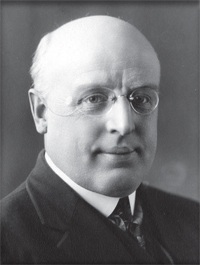Page Content
This is a photo of students who attended the one-room schoolhouse in Dorenlee, which is about 40 kilometres south of Camrose, Alberta. It was taken in 1907.
Photo courtesy of the Provincial Archives of Alberta
 To hear the name William Aberhart calls up thoughts of the Social Credit dynasty in Alberta politics and, perhaps, his fiery “Back to the Bible” hour on radio, but most people today know little of Aberhart’s contributions to education in Alberta.
To hear the name William Aberhart calls up thoughts of the Social Credit dynasty in Alberta politics and, perhaps, his fiery “Back to the Bible” hour on radio, but most people today know little of Aberhart’s contributions to education in Alberta.
William Aberhart (1873–1943) was born in Perth County, Ontario. He qualified as a school teacher at the Normal School in Hamilton, Ontario, and began teaching at Central Public School, in Brantford, Ontario, in 1901, becoming principal in 1905. Because he wanted to become a Presbyterian minister, he began BA studies through Queen’s University (which he completed in 1911, after he had moved to Alberta). While still in Ontario, he became a lay preacher and Bible-class teacher.
In 1910, Aberhart moved to Calgary, where he became principal of Alexandra Public School then of Victoria School. In 1915, he became principal of the new Crescent Heights High School, where he remained for the rest of his teaching career.
At the same time, he continued his activities in religious instruction. The Calgary radio station CFCN began broadcasting his Sunday afternoon services at Westbourne Baptist Church in 1925. In 1927, Aberhart was appointed dean of the newly established Calgary Prophetic Bible Institute. He continued his radio broadcasts all the while continuing as principal of Crescent Heights High School.
The Great Depression hit the western Canadian economy hard, and people were drawn to Aberhart’s ideas. Aberhart became interested in monetary reform, particularly the ideas of one Major C. H. Douglas, which became known as social credit. Aberhart modified and popularized these ideas; to promote them, he founded the Alberta Social Credit League, which eventually developed into a full-fledged political party.
During this time, Aberhart continued teaching. He must have been shocked, then, when he, along with all the other teachers employed by the Calgary Board of Education, was fired and invited by the board to come back to work on salary terms determined solely by the board. Aberhart did not return. Instead, he pursued his political ambitions and was greatly rewarded when, in 1935, Social Credit took 56 of the 63 seats in the Alberta legislature. Aberhart became premier and minister of education.
Arguably, Aberhart’s most important contribution to the education profession was his modifications of the Teaching Profession Act, which had been passed in 1935 by the previous United Farmers of Alberta government. The act had enshrined in legislation that teaching actually was a profession and it specified that the name of the teachers’ organization was henceforth to be the Alberta Teachers’ Association (though membership in the Association was not mandated). In 1936, the Social Credit government amended the Teaching Profession Act such that membership in the Association was automatic for all teachers in Alberta’s public schools (including the publicly funded separate schools).
Aberhart and his government contributed immeasurably to the profession:
The new government moved vigorously into the field of educational legislation. Within a few years it had made a beginning on a contributory pension scheme for teachers, provided them with the security of tenure, established an independent tribunal to act in the case of dismissals of teachers, set up collective administration, and initiated moves which were ultimately to place all teacher education in the hands of the provincial university. (Chalmers 1968, 129)
In the words of Clarence Sansom, in the June 1943 issue of the ATA Magazine, “He did all a man could do in the legislative field in the time that was given him to make schools better places for children to attend, and teaching a calling of dignity and respect.”
References
Chalmers, J. W. 1968. Teachers of the Foothills Province. Toronto, Ont.: University of Toronto Press.
Sansom, C. 1943. “President’s Column.” ATA Magazine, June: npn.
